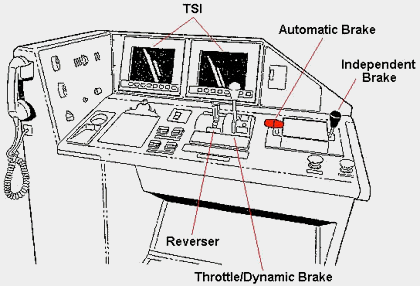Integrated Cab
Electronics

As the demand for locomotive/train control devices in the cab of the locomotive continues to increase,
a desire to integrate these systems becomes apparent. Electo-Motive and
Rockwell International have designed a system called Integrated Cab Electronics or
ICE to serve this purpose. ICE consolidates the function of speed indicators, crew
alertness systems, End Of Train telemetry, and many other systems. The visual
indications normally observed on these separate systems are integrated on a colour
screen called a Train Situation Indicator or TSI. In order to accomplish all present
duties, the ICE system uses two separate TSIs mounted on the operator's control
console. In addition to providing EOT data and speed indications, the colour TSI also
displays control stand warning indicators such as PCS Open, Sand, and Wheel Slip. Air
brake gauges, the load meter, torque meter, and the locomotive's diagnostic display
system have all been replaced by the colour monitors. The TSI also provides a method
for changing air brake set-up, operating remote units at other locations
in the train, and cab signalling if so equipped. As an option, a third TSI may be
installed at the conductor's work station.
| |

Train Situation Indicators on a Union
Pacific demonstrator - Greg Sherwood.
|
Although they may seem to be, these display units are not the heart of the ICE system.
Data exchange between ICE and other locomotive systems are carried out by the Cab
Consolidation Computer. This computer, referred to as the CCC, interfaces with the
EM 2000 locomotive control system, the electronic air brake computer, cab signalling
system (if installed), EOT telemetry system, and distributed power computer (if
installed). The CCC also replaces the event recorder.
In addition to consolidating existing systems and indicators, the ICE system has
provisions built in for expansion to include such features as Distributed Power,
Health Monitoring, ATCS or PTS, and "Train Orders". ATCS of PTS is a system
through which an operator can see immediate track information over the next few miles
decreasing the chances of collisions. Data conveyed includes speed restrictions,
status of trackside signals, grade and curvature, estimated stopping distance (based
on train weight, grade, etc.), and other information.
©
2005 William C. Slim
http://www.okthepk.ca
|

